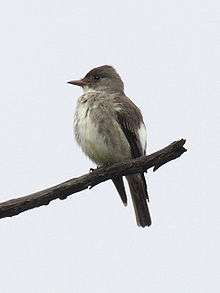Olive-sided flycatcher
| Olive-sided flycatcher | |
|---|---|
 | |
| Scientific classification | |
| Kingdom: | Animalia |
| Phylum: | Chordata |
| Class: | Aves |
| Order: | Passeriformes |
| Family: | Tyrannidae |
| Genus: | Contopus |
| Species: | C. cooperi |
| Binomial name | |
| Contopus cooperi (Swainson, 1832) | |
The olive-sided flycatcher (Contopus cooperi) is a passerine bird. It is a medium-sized tyrant flycatcher.
Description
Adults are dark olive on the face, upperparts and flanks. They have light underparts, a large dark bill and a short tail.
The song is a whistled quick-three beers. The call is a rapid pip pip pip.
Systematics
Contopus borealis is a junior synonym of Contopus cooperi, according to the 1997 AOU checklist, quoted by BISON. The name of this species is listed as Contopus borealis in many older guides.
Distribution and habitat
Their breeding habitat is coniferous woods across Canada, Alaska and the northeastern and western United States, and other types of wooded area in California. Olive-sided flycatchers are abundant in early postfire landscapes that have burned at high severity.
These birds migrate to Central America and the Andes region of South America.
Behavior
Feeding
They wait on a perch at the top of a tree and fly out to catch insects in flight.
Breeding
The female usually lays three eggs in a shallow open cup nest on a horizontal tree branch. The male defends a large area around the nesting territory. Both parents feed the young birds.
Status and conservation
The numbers of this bird are declining, probably due to loss of habitat in its winter range.
References
- ↑ BirdLife International (2012). "Contopus cooperi". IUCN Red List of Threatened Species. Version 2013.2. International Union for Conservation of Nature. Retrieved 26 November 2013.
Further reading
- Willis, E.O.; Snow, D.W.; Stotz, D.F. & Parker III, T.A. (1993) Olive-sided Flycatchers in Southeastern Brazil Wilson Bulletin 105(1):
External links
| Wikimedia Commons has media related to Contopus cooperi. |
| Wikispecies has information related to: Contopus cooperi |
- Olive-sided flycatcher - Contopus cooperi - USGS Patuxent Bird Identification InfoCenter
- Olive-sided flycatcher x=species account - Cornell Lab of Ornithology
